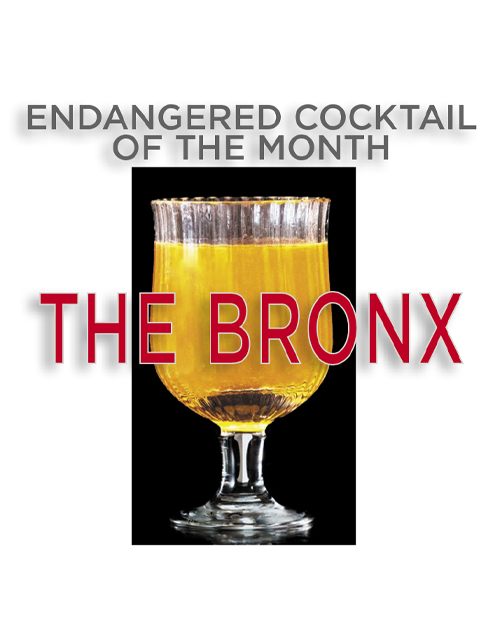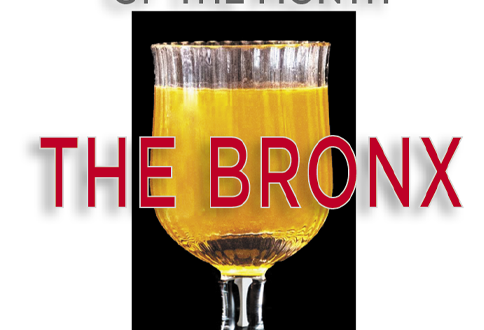THE BRONX
 by PINK LADY
by PINK LADY
Of all the pre-Prohibition drinks named for New York City boroughs, the Manhattan has had the longest life and the most staying power. It may in fact be the only classic cocktail that was never actually endangered. But as Frank Caiafa shares in his 2016 The Waldorf Astoria Bar Book, in its heyday the Bronx Cocktail was the real belle of the ball: “Of all the cocktails associated with or attributed to the Hotel, not one — not even the venerable Rob Roy — was as popular as the Bronx,” Caiafa writes.
The Waldorf Astoria is as emblematic of old New York luxury as they come. It was originally two properties built 4 years apart by rival cousins: the Waldorf built in 1893 by William Waldorf Astor at 33rd St and 5th Avenue, and the Astoria built right next door by cousin John Jacon Astor IV, which stood four stories taller. Their family feud was eventually set aside to combine the two hotels, adjoining them with a walkway known as “Peacock Alley” where the rich and famous would strut in their finery. That hotel would be demolished in 1929 to make way for the Empire State building, with the Waldorf Astoria reopened in a new location on Park Avenue in 1931. The property has been closed for renovations since 2017, slated to reopen in 2024.
Caiafa’s The Waldorf Astoria Bar Book is a delightful mashup of recipes from “the old bar”, as memorialized by former newspaperman and publicist for the hotel Albert Stevens Crockett, and recipes from Caiafa’s tenure as the beverage director at the hotel from 2005-2016. Crockett’s 1931 book Old Waldorf Bar Days was recorded purely for posterity to immortalize the old hotel in all its glory, published in the midst of Prohibition: “almost as an afterthought, it included 489 recipes, almost none of which could be made legally (much less properly) in the entire United States of America,” writes Caiafa. After repeal, as the nation relearned how to make proper cocktails, Crockett’s publishers encouraged him to reimagine his book as The Old Waldorf-Astoria Bar Book with a focus on the old recipes. He published two editions, one in 1934 and a second release in 1935. The recipes themselves are sourced from an actual bar book used by one of the Old Bar’s original bartenders, Joseph Taylor, who recorded his mixing instructions and notes in leather bound volume that he gifted to Crockett after serving his last drinks in 1929.
In its heyday, the Men’s Bar at the Old Hotel (as Caiafa refers to it) was the spot: “It was open from six a.m. to one a.m. (if not later) daily, and no less than ten bartenders were on hand, serving famous concoctions to crowds that grew to more than three deep during the hours between four p.m. and seven p.m.” As toney as the hotel was, the bar catered to “all strata of society, from steel magnates to construction workers and everyone in between,” writes Caiafa. In the years before Prohibition, The Bronx was one of the most requested cocktails, sometimes referred to as “the Cosmopolitan of its day.” As for the true origins of the drink, there are conflicting stories, but the one I like features bartender Joseph Solan mixing one up on the fly when challenged by a waiter to “create a new quencher on the spot.” Based on a Duplex cocktail, which he had just mixed for a guest, “he basically added gin and orange juice to the Duplex and the Bronx was born — supposedly named for rowdy guests who reminded him of a recent trip to the zoo.” The drink would become a lunchtime special and was eventually so popular that the bar went from using about a dozen oranges a day for service to several cases. Why not mix one up for a daytime tipple this June?
THE BRONX (modern)
From Frank Caiafa’s The Old Waldorf Bar Book
1.5 ounces of Beefeater London dry gin
.5 ounce of Cinzano Rosso sweet vermouth
.5 ounce of Noilly Prat extra dry vermouth
1 ounce of fresh orange juice
1 dash Regan’s orange bitters
Add all ingredients to a mixing glass.
Add ice and shake well.
Strain into a chilled cocktail glass.
No garnish.
Cin-cin!!

